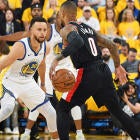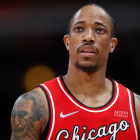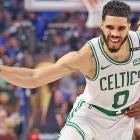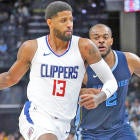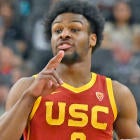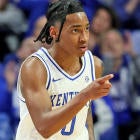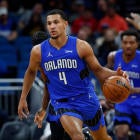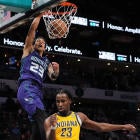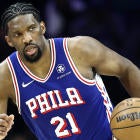These tiers assume eight category settings. Within each tier, players are listed in recommended draft order:
Tier 1: Potential first overall picks
James Harden, Rockets
Steph Curry, Warriors
Both players are reasonable choices to start off a draft, though both come with more uncertainty than in recent years. For Harden, who has been dominant as the No. 1 player in eight-category leagues over the past three seasons, the uncertainty stems from the addition of Russell Westbrook. Harden and Westbrook sit atop the all-time record books for usage rates in a season – will Westbrook's arrival dampen Harden's Fantasy value? And, if so, by how much?
As for Curry, there is some risk in how D'Angelo Russell's arrival impacts his game, but, frankly, that's a relatively minor concern, as Curry's Fantasy situation probably improved overall this offseason. The bigger issue is the crowded Western Conference combined with the Warriors' short- and long-term health outlooks. Curry appears bound to get some rest nights no matter what. If the Warriors fall out of the playoff hunt early, how many games will Curry "load manage"?
Tier 2: Mid-first-round value
Lillard stands alone here. Many have described the top of 2019 Fantasy drafts as the top-five plus Nikola Jokic. I think it would be fair to extend that to the top-five plus Jokic plus Lillard, as Lillard might go seventh overall almost as often as Jokic goes sixth. After the top-six this season, Fantasy drafts enter a minefield that lasts for nearly 25 picks – a range in which almost all of the players are either: injury risks, in a new situation that could be unfavorable, or young prospects for whom we are assuming development we're yet to see.
While Lillard doesn't offer nearly the upside of the top-five plus Jokic, he poses by far the least amount of risk of anyone else in this range. He's been a top-20 player in 8-cat for five straight years and a top-12 player for the last two. His situation is stable, and he's never missed more than nine games in a season. Draft Lillard with confidence.
Tier 3: The borderline elite
Kemba Walker, Celtics
Russell Westbrook, Rockets
Kyrie Irving, Nets
Realistically, these players will probably finish in reverse order, according to the per-game 8-cat ranks. But Irving has proven to be a massive injury risk. I'm legitimately concerned by how much Westbrook's value suffers when playing alongside Harden, and Westbrook also has some notable injury issues of his own. His advantages come from his aggressive, forceful game, but he's had multiple knee surgeries and will turn 31 in November. Westbrook is not the kind of player who fades away slowly – when his crash comes, I expect it to happen suddenly. That's not to say 2019-20 is the year it all falls apart for him, but his floor is far below that of anyone else in this tier, or of anyone in Tier 4.
Meanwhile, Walker's game-to-game ceiling is certainly lower than that of Irving or Westbrook, but he's been a bastion of health, and he's on the most talented team of his career. He's missed only four games combined over the past three seasons. The upgraded roster around him should help him average near-career-highs in assists and field goal percentage. At the same time, the Celtics will still need him to be a leading scorer, so I expect minimal drops in points or threes.
Tier 4: The riskier options
Mike Conley, Jazz
Luka Doncic, Mavericks
Trae Young, Hawks
Ben Simmons, 76ers
Jrue Holiday, Pelicans
Chris Paul, Thunder
Kyle Lowry, Raptors
The point guard position is fairly top-loaded this year. The 15 players housed in the first five tiers are likely to be drafted inside the top 40 overall. Tiers 6, 7 and 8, which include only six players combined, span roughly picks 40 to 80. That means that if you don't get your point guard early, you will be significantly worse at the position than your competition. With that in mind, even though all of the players in Tier 4 carry significant risks this early in a draft, all of them are worthy inclusions.
As with Tier 3, some might quibble with my ordering, but since there is such a premium on getting a reliable point guard early in drafts this year, my top players in this tier are the ones I view as most likely to achieve that goal of reliability.
It's true that Conley's ceiling might be the lowest of anyone's in this tier, but we can draft him with confidence. He's been a top-55 player every time he played at least 60 games this decade, and he's been a top-30 player four times, including last season. Sophomores Doncic and Young will probably have the highest ADPs of this group, but we need to be wary of making a classic Fantasy mistake: forgetting that development is non-linear.
Holiday ranked inside the top-20 in each of the last two seasons, but he also finished fifth in minutes per game in 2018-19. His workload is almost certain to take a hit this year with the Pelicans acquiring multiple players capable of playing point guard.
Meanwhile, both Paul and Lowry have troubling injury histories and are 34 and 33, respectively. But they also have lengthy track records of top-25 production and appear in line for increased usage rates this season following, in Paul's case, a change of scenery, and, in Lowry's case, the departure of Kawhi Leonard.
Tier 5: Outlook unclear
De'Aaron Fox, Kings
D'Angelo Russell, Warriors
In terms of real basketball, Fox was a revelation last season. He very quickly went from um, sure, he's got potential and failing to make the All-Rookie Second Team to tracking as a possible future superstar. In terms of Fantasy, however, Fox barely slipped inside the overall top 50. He still has room to improve, but we never want to draft someone assuming their best-case outcome.
As for Russell, he's likely to see an increase in minutes as part of a shallow Warriors backcourt. That's the pro, and it's a big one. The con? Can he maintain a 32 percent usage rate playing next to Steph Curry? And what happens if he gets traded midseason, a possibility that was universally acknowledged as soon as news of the unexpected sign-and-trade broke.
Tier 6: The upper-middle class
Jamal Murray, Nuggets
Malcolm Brogdon, Pacers
Eric Bledsoe, Bucks
If any of these players are your team's third point guard, then you'll have a huge advantage at one of the most influential positions. If any of these are your second point guard, then that's a solid start, especially if you're focusing on a build that de-emphasizes assists. If any of these are your first point guard, then either you already grabbed Jokic or Draymond Green, or you are punting assists hard.
All three of these guys will help with threes and rebounds. Murray and Brogdon will help your free throw percentage, while Bledsoe and Brogdon will help your field goal percentage. Bledsoe probably has the highest floor, but the lowest ceiling. Brogdon is the best for all-around value, especially in 9-cat leagues. Murray should be the best in points, and likely by a sizeable margin.
Tier 7: Youth with upside
Shai Gilgeous-Alexander, Thunder
Lonzo Ball, Pelicans
Gilgeous-Alexander is now the face of the future of the Thunder franchise. His new role plays a huge part in him jumping up draft boards, but it's not all hype. At point guard, he can help in both percentage categories, and he has a shot at providing "1-1-1" value (one steal, one block, and one three per game). He'll begin the season sharing the court with one of the smartest floor generals of all time in Chris Paul. And Gilgeous-Alexander's numbers only improved over the course of his rookie season.
In New Orleans, Ball finds himself in a less advantageous depth chart situation than last season, and the fact that he's missed a combined 75 games over his first two seasons must be considered. Nonetheless, he still carries significant upside. The No. 2 pick in 2017 was a key piece of the Pelicans' return in the Anthony Davis trade, and Ball finished inside the top-55 as a rookie. Yes, he's a been a dreadful shooter in the NBA, but he was much more efficient in college, so improvements in that area could come at any time. Until he proves he can stay healthy for more than half a season, Ball will carry inherent risk, but he's worth a selection once the more reliable point guards are off the board.
Tier 8: The lower-middle class
Rubio fell out of favor by the end of his tenure in Utah, but he's a great addition for a Suns team that was in desperate need of help at the position. His presence alone increased my ranking of Devin Booker and Deandre Ayton by more than five spots. But Rubio, himself, remains limited. At only 28 years old, Rubio remains a dark-horse candidate to lead the league in assists, depending on how the Suns use him. He's still a nifty thief, though his steals rate has fallen off significantly over the past few years. He's a woefully inefficient shooter and he provides no help in points. In certain punt builds, he's a fantastic option worth reaching for. But for most managers, Rubio creates almost as many holes as he fills.
Tier 9: High-minute-getters
Derrick Rose, Pistons
Tomas Satoransky, Bulls
Ja Morant, Grizzlies
Terry Rozier, Hornets
Derrick White, Spurs
Morant is the flashy name, but rookies drafted inside the top 100 almost never return fair value. Buyer beware. Rozier is now the leader of the Hornets, but is the early favorite to be the league's biggest drain in field-goal percentage. Plus, he's a mediocre-at-best passer with no one to pass to. He'll probably back his way into solid points, rebounds, and threes production, but not every roster will be equipped to overcome his damaging efficiency.
White is likely the Spurs' top PG, but he now faces a threat to his minutes with Dejounte Murray returning to action. Can White continue to build on last season's progress despite a more crowded backcourt?
Further down, Rose and Satoransky are both risks. Satoransky should start the season as the Bulls' starter, but how long can he hold off Coby White, their 2019 lottery pick? Rose has a well-known history of health problems, and he is likely to come off the bench behind Reggie Jackson. Was last season the start of a new era for Rose – the reliable veteran, leader of the second unit, guy who plays in crunch time? The Pistons have been reluctant to stick with Jackson in crunch time in the past, but that doesn't mean Rose's role from last season will automatically transfer to his new team.
Tier 10: Missing either upside or a floor, but not both
Coby White, Bulls
Jeff Teague, Timberwolves
D.J. Augustin, Magic
Delon Wright, Mavericks
Collin Sexton, Cavaliers
Patrick Beverley, Clippers
Elfrid Payton, Knicks
Monte Morris, Nuggets
Teague, Augustin, and Wright all feel like locks to finish the season ranked between 90th and 110th. They are perfect if you like your team and are looking for some stable -- albeit unexciting -- point guard depth. Teague and Augustin produce more traditional stats, while Wright's value comes more from his 1-1-1 potential (though getting to 1.0 blocks per game might be a stretch).
White, Sexton, Payton and Morris could all be waiver-wire afterthoughts before Thanksgiving – but if they find themselves reliably playing more than 25 minutes per night, they'll be worth rostering. All four have a chance, small as it may be, of earning more than 30 minutes per night. In that case, they'd likely become universally rostered and potentially even season-defining pickups.
Beverley is the odd man out in this tier, not really fitting either description. Playing next to Kawhi Leonard and Paul George and sharing the backcourt with Lou Williams cuts into Beverley's already-limited offensive appeal. However, Williams is entering his 15th NBA season, and the biggest reason Beverley's minutes dropped last season was Shai Gilgeous-Alexander, who is now in Oklahoma City. When given enough minutes, Beverley has a proven track record of top-100 value, mostly on the strength of his threes and steals.
Tier 11: Boring but (probably) not useless
Reggie Jackson, Pistons
Rajon Rondo, Lakers
It's the end of the draft. Maybe you're in a very deep league. Or maybe you're worried about your depth. Well, lucky for you, these players exist. Maybe they'll even provide some value. Maybe.








